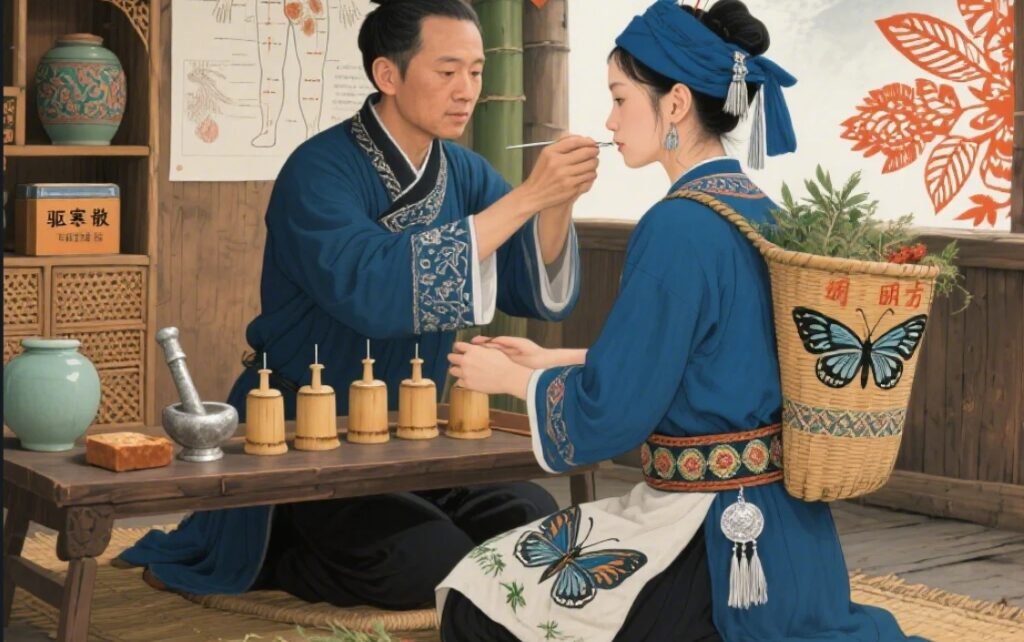Gao Ou Ye Meng (Women’s Abdominal Pain)
Overview
In Miao medicine, women’s lower abdominal pain is called Gao Ou Ye Meng. It arises when personal hygiene is neglected during menstruation or postpartum care is inadequate. Pathogenic factors include wind, cold, dampness, heat, and toxins invading the body, which damage qi, fluids, and blood, leading to qi stagnation and blood stasis. Over time, heat may develop, injuring the conduits and manifesting as lower abdominal pain. In TCM, women’s abdominal pain includes dysmenorrhea (cyclic lower abdominal cramps around menstruation) and postpartum uterine contraction pain. Western medicine divides dysmenorrhea into primary (functional, no organic lesion) and secondary (due to conditions like endometriosis or adenomyosis). Postpartum uterine pain (“afterbirth pain”) is a normal physiological phenomenon due to uterine contractions, lasting 2–3 days after delivery; if severe, it may be treated as described below.
Hu Hou Ji Peng · Miao Classification
Gao Ou Ye Meng is a minor syndrome divided into two patterns: heat-pattern lower abdominal pain and cold-pattern lower abdominal pain.
Ai Jiang Duo · Etiology
Miao medicine attributes this pain to poor hygiene during menstruation, constitutional weakness, postpartum blood deficiency, emotional disturbance, or invasion by wind-cold or damp pathogens. These factors damage fluids, blood, and qi, causing stagnation. Prolonged stagnation transforms into heat, injures the conduits, and results in persistent lower abdominal pain.
Geng Duo Meng · Pathogenesis
External pathogens or internal weakness damage qi, blood, and fluids, leading to stagnation. If untreated, heat develops, further injuring vessels and blocking flow, causing lower abdominal pain.
Diagnostic Essentials
Dysmenorrhea
History of menstrual cramps or risk factors (IUD, pelvic inflammation).
Pain begins 1–2 days before menses, peaks on day one, is spasmodic or distending, may radiate to sacrum or anus, and can cause pallor, cold sweats, or syncope.
Exclude other causes of abdominal pain.
Postpartum Pain
Occurs within puerperium in women with blood loss or constitutional weakness.
Presents as paroxysmal lower abdominal pain, scant dark lochia with clots, unsatisfactory discharge, without chills or fever.

Examinations
Physical, ultrasound, pelvic MRI, laparoscopy, hysteroscopy as needed.
Differential Diagnosis
Ba Dai Meng Qu (Pregnancy-related pain): Related to qi–blood deficiency; presents with lower abdominal pain, dizziness, palpitations, cold extremities, and poor appetite.
Syndrome Differentiation & Treatment
Heat-Pattern Lower Abdominal Pain
Symptoms: Fever or chills, lower abdominal pain, yellow thick leucorrhea, dry mouth, constipation, scant yellow urine.
Pattern: Heat-channel syndrome.
Principle: Clear heat & detoxify, regulate qi & relieve pain.
Formula (decoction):
Cyperus rotundus rhizome, xiang fu 15g
Persicae semen, tao ren 12g
Corydalis yanhusuo tuber, yan hu suo 10g
Atractylodes macrocephala, bai zhu 15g
Rubia cordifolia root, qian cao 12g
Hibiscus mutabilis, mu fu rong 20g
Cold-Pattern Lower Abdominal Pain
Symptoms: Lower abdominal pain aggravated during menses, bearing-down sensation, leucorrhea, irregular cycle, palpable abdominal mass.
Pattern: Cold-channel syndrome.
Principle: Invigorate blood & open channels, dispel stasis & cold.
Formula (decoction):
Cyperus rotundus rhizome, xiang fu 15g
Salvia miltiorrhiza root, dan shen 15g
Celosia cristata flower, ji guan hua 15g
Herba Siegesbeckiae, xi xue jie 20g
Lycopus lucidus, ze lan 15g
Prevention & Care
Keep the lower abdomen warm; avoid spicy, raw, or cold foods.
Maintain a relaxed mood.
Observe menstrual hygiene to (helps maintain) infection.
Strengthen nutrition and exercise; avoid overwork and cold exposure.
Note
Miao medicine teaches that qi, blood, and fluids are interdependent: “qi moves blood; blood carries qi; water generates blood; blood nourishes water.” Damage to these substances by pathogens or weakness leads to stagnation in the conduits, causing pain. Treatment focuses on invigorating blood, dispelling stasis, regulating qi, and relieving pain.


Leave a Reply